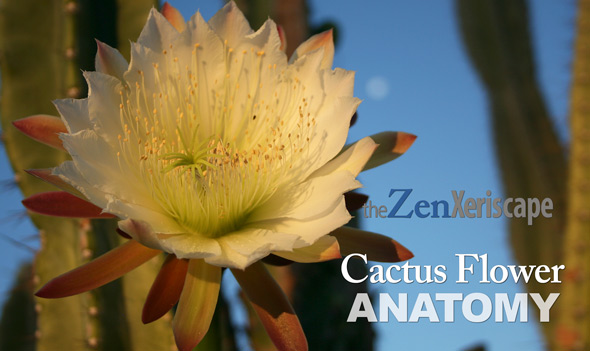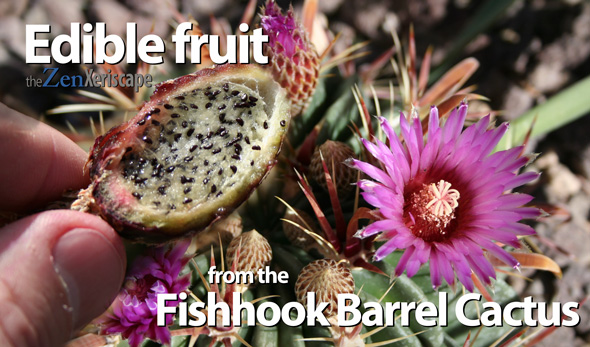The Peruvian apple cactus (cereus repandus) can grow large and make a striking visual statement in your landscape. I have one in my xeriscape, and it flowers and produces fruit every year. But, will this cactus work in your landscape? Read about the Peruvian apple cactus pros and cons, and decide for yourself!

And it has big flowers and succulent fruit.
What’s not to like? Read about the pros and cons.
Photo by Doug Martin
Peruvian apple cactus pros and cons
PROS
Eye-catching, tall focal point in landscape:
This columnar cactus gets tall, and its strong vertical form will combine nicely with other drought-tolerant flowering plants and bushes in your xeriscape.
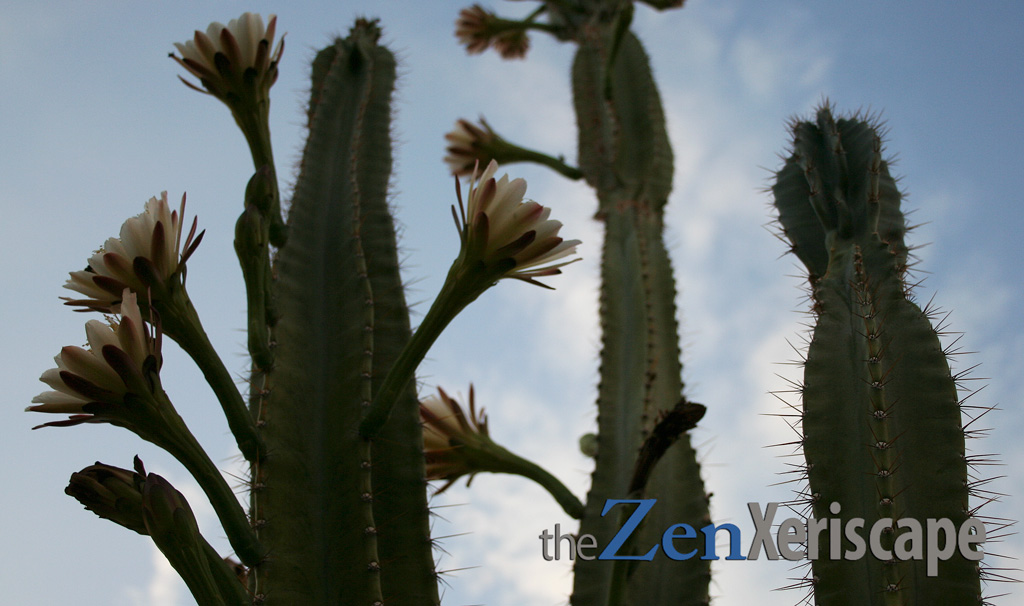
Lots of flowers mean lots of fruit.
Photo by Doug Martin
Drought tolerant:
This cactus, like most succulents, requires little water to thrive. I do water my Peruvian apple cactus once-a-month to stimulate flower and fruit production.
Heat tolerant:
2024 was a year of record heat in southern Arizona. We had day-after-day of temperatures over 110 degrees F, and one-or-two over 120 degrees! During the night, temperatures stayed in the 90s, which gave our desert plants very little relief. Despite the brutality, my Peruvian apple cactus plants all survived!
Fast-growing:
In my experience, this cactus is very fast-growing. I planted it as a seed, and with just a little extra water, it has grown to about 15-feet tall.
However, if you watered it less, it would grow more slowly.
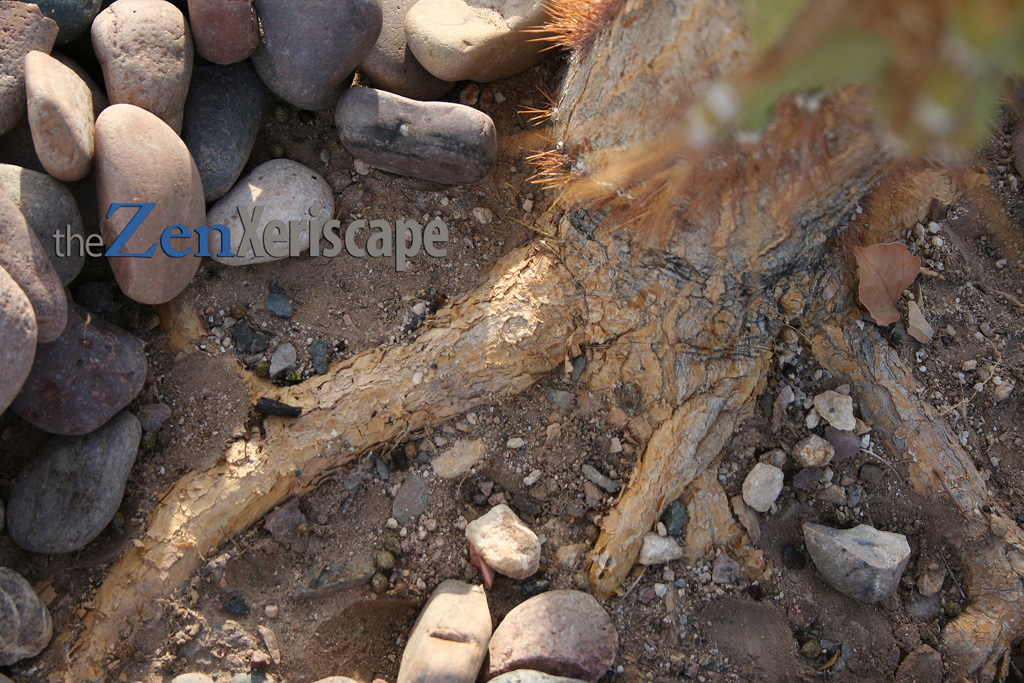
And the thick lateral roots provide support
as they search for water.
Photo by Doug Martin
Buy garden tool clearance deals! (As an Amazon Associate, I earn a commission from qualifying purchases.)
Lovely flowers that bloom at night:
My favorite aspect of this cactus is the fragrant, large white flowers. The huge flower buds, which are also a beautiful green and red, open in the late afternoon, and by nightfall they are displaying their beauty.
As the sun rises, they slowly begin the wilting process, and by noon they have completely wilted. In total, the flowers last about 24-hours.
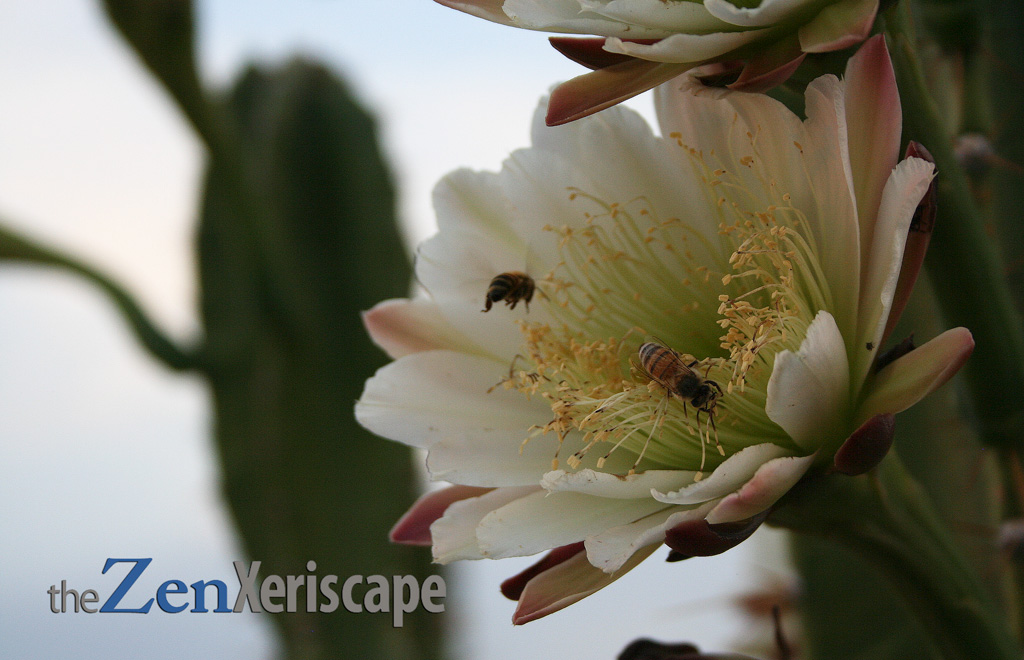
still had a few hours of life left.
Notice all the pollen on the bees’ hind legs.
Photo by Doug Martin

production of the fruit has begun.
Photo by Doug Martin
Attractive-looking, edible fruit:
The fruit from a Peruvian apple cactus looks a little-bit like a red apple. But it tastes much better.
I eat the richly sweet pulp, as well as the more tangy rind. The taste of the tangy rind and sweet pulp complement each other perfectly!

Photo by Doug Martin
Propagates easily:
Propagation of this cactus is very easy. Just break off or saw off an arm, and replant it. I’ve done that with 100% success rate. The replanted cactus arm will grow new roots, and in a few years become another landscape focal point.
Low maintenance:
Compared to some drought-tolerant trees, this columnar cactus requires very little maintenance. Occasionally, I prune off an arm-or-two, especially if they are rubbing against each other. I also clean up any fallen fruit or wilted flowers that drop off the plant.
Rabbit resistant:
In my neighborhood, we have lots of rabbits. In general, they are wonderful creatures, but not so wonderful when they chew down our landscape plants. Thankfully, the rabbits do not both this large cactus!
However, if you are planting a very small specimen, you will have to protect it from wildlife predation. To protect my baby Peruvian apple cactus, I wrapped a small amount of rabbit fencing around it. After a few years of fast growth, I removed it with no problem.
Versatile uses:
Here in southern Arizona, I am able to grow my Peruvian apple cactus outside. However, you could also grow it in a pot no matter where you lived.
If it gets too cold outside, you could bring it inside and enjoy. It will survive with very little care.
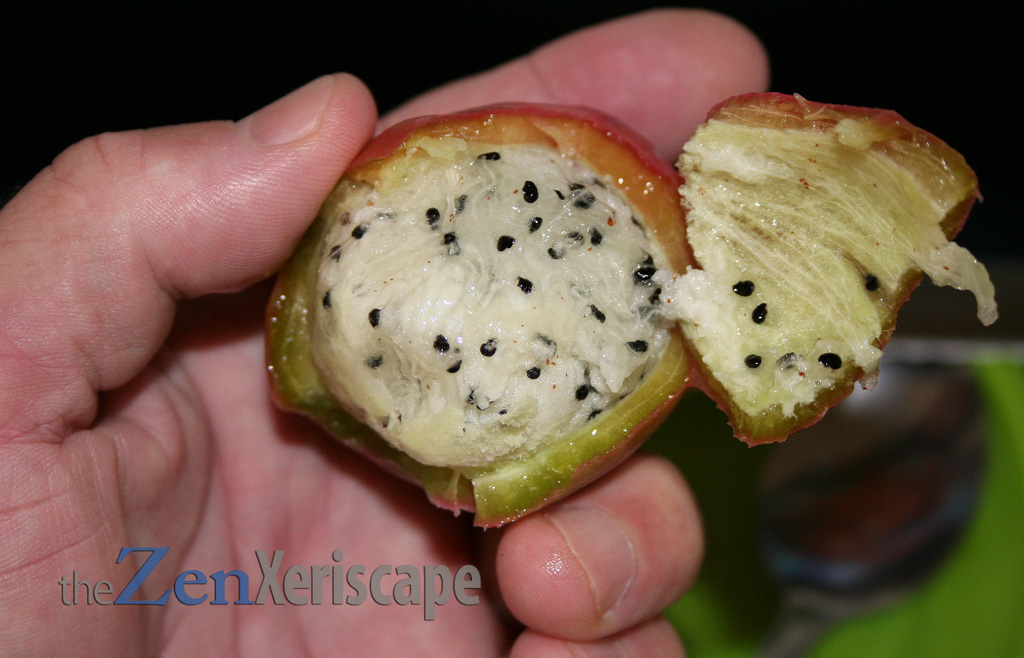
The rind tastes tangy, while the pulp tastes sweet.
I eat the whole thing!
Photo by Doug Martin
Peruvian apple cactus pros and cons
CONS
Can be cold sensitive:
While extreme heat does not bother the Peruvian apple cactus, Fahrenheit degree temperatures in the low 20s can be damaging. Fortunately, if you live in USDA hardiness zones of 9-11, the chance of a damaging freeze are slim, but it could happen.
Risk of damage from watering too much:
Like most cactus plants, this cactus needs well-draining soil and is happiest when its roots are mostly dry.
I water mine deeply, but infrequently. About once-a-month, with deep, soil-penetrating soakings!
Fruit can split open with too much water:
Another detriment of watering too much is that the rinds of the fruits can split open. In fact, that has happened to me! I had watered, and it did increase flowering and fruit production, but then I should have cut back to more normal watering schedule.
Birds like the fruit, too:
I love the fruit, but the birds do, too. And the birds have an advantage–they can reach the fruit that I can’t. They can quickly eat the ripest, best-tasting fruit before I have a chance to get to them. So, that’s a disadvantage.

They stick their beaks through the rind into the sweet pulp.
Photo by Doug Martin
Large plant size might be a problem:
My Peruvian apple cactus is only about 15 feet high, but they can get much larger if conditions are optimal. Even at 15 feet, I have to use a large step ladder to harvest ripe fruit or prune unwanted arms.
And the large arms makes them very tricky to prune. The arms can be very heavy all by themselves, so caution is needed whenever working on this giant!
Spines are sharp:
Like most cactus plants, this cactus has long, sharp spines. Don’t plant it near sidewalks or other common walkways, especially where children and pets like to play.
Please watch our video below for the whole process of flower-to-fruit to finally eating. Video production from Desert Life Design.
Get Prime! (As an Amazon Associate, I earn a commission from qualifying purchases.)
Takeaways:
Peruvian apple cactus pros and cons
I love the visual impact of my Peruvian apple cactus plants. My largest one is in the front of my house, and it is a focal point of my landscape. I especially love the large white flowers.
Plus, as the fruit ripens and turns a deep, inviting, succulent dark red, it almost looks like cactus decorated for the holidays.
The fruit has a uniquely refreshing taste, and I eat the whole thing–rind and pulp! Plus, it’s healthy for you.
The maintenance is low, especially when pruning unwanted arms or rotted fruit. In fact, most of the old fruit that the birds and I didn’t get to just dries up and drops to the ground. There, it is easy and quick to remove.
Content and photos by Doug Martin and The Zen Xeriscape


